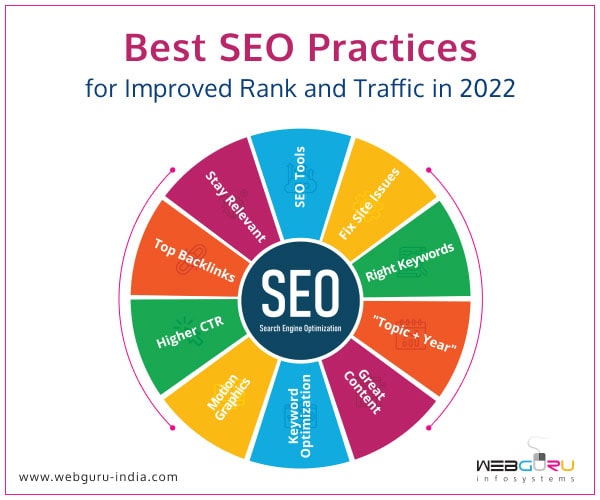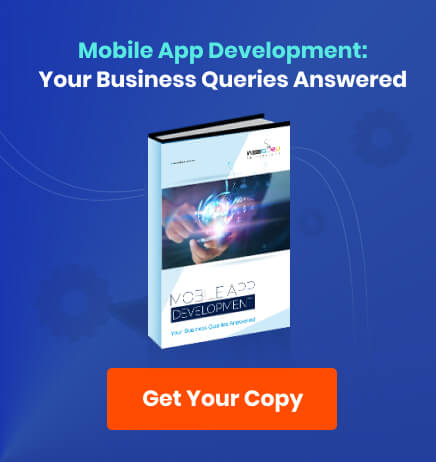Home Blog SEO Services Best SEO Practices for Improved Rank and Traffic in 2022
Best SEO Practices for Improved Rank and Traffic in 2022
- 27 May / 2022
- 6,652 views

Across the world, SEO services keep updating their approaches in order to keep up with the time. This is because both search engines as well as consumers’ demands keep evolving, and SEO strategies must evolve with them. Here are some of the best SEO practices that should prove helpful in 2022.
Some Advanced SEO Strategies for 2022
SEO is an ever-evolving and ever-growing field. And with the advent of AI, the future of SEO could also be changing very soon. Here are some of the best SEO practices for 2022.
1. Use Effective SEO Tools
SEO tools will save you from the tiring work of keyword research and analysis. They will easily let you know which parts of your strategies are working well, and which ones need tweaking. Good SEO tools will also send you reports which you can use to see how you fare against competition, and where you can find opportunities. SEO tools can also help you manage multiple websites on the fly, saving you hours of effort.
Google Search Console
The Google Search Console is offered to anyone having a website for free. It lets you monitor your site’s presence in the Google SERPs. You first need to add a piece of code to your website in order to verify it, after which you may submit your sitemap for indexing. Using the console, you can now control what gets indexed. The Google Search Console also helps you understand exactly what keywords your site ranks for. This way you can optimize your site much better for Google.
Analytics
Google Analytics is a widely used tool, across hundreds of thousands of websites across the internet. With this tool you can analyze your web traffic, identify your top content, monitor valuable marketing channels, and also analyze user behavior such as click through rates, average time spent, bounce rates, etc.
SEO Plugins
For WordPress-based websites, plugins such as AIOSEO and Yoast SEO are enormously helpful. These plugins will help you generate content that is perfectly optimized for search engine crawlers by conducting on-page SEO analysis. These tools also help in writing metatags, sitemap generation, and social media integration.
2. Find Keywords that Customers Search For
Keyword research will bring you valuable insight into what your target audience actually wants. When researching online, people search using these keywords. With this information, you can make an informed content strategy (and your larger advertising and marketing strategies as well). Here are a few strategies to consider in 2022 when researching keywords.
Find long-tail keywords with Google Suggests
Long-tail keywords are longer keyword phrases that contain 3 or more words. It is important that your content has a mix of short and long-tail terms, because this kind of keyword strategy is well-suited to both short-term as well as long-term goals. This is simply because the shorter keywords are frequently searched, making them much more difficult to rank for. Some ways to research effective long-tail keywords are:
- Type in a keyword in the Google search bar, but don’t press enter. Instead, look at the alternate suggestions that Google provides. These are commonly searched keywords.
- The “People also ask” section now gets displayed on the Google SERP for almost 85% of searches. It is a great way to incorporate longer keywords, as this feature lets you understand exactly what questions users are asking.
- The footer of the SERP will also display search terms that are related to what you have searched. This section also provides insights into what keywords people are searching for.
Google Keyword Planner
Google keyword research tool can help you understand how often certain words are searched, and how they have changed over time. This will help find keywords that are most relevant for your business, and then strategise around them. Most people generally simply type seed keywords into the Google Keyword Planner for ideas. However, if you enter your page’s URL into it, the tool will scrape that page for and generate a lot more keywords that you wouldn’t normally see.
Popular Forums
Reddit has a discussion board for seemingly every topic on earth. This makes it a treasure trove of research for marketers. You can use it to understand what queries people have, and this will give you a significant insight into what keywords you should use. Similarly, you can use Quora and other popular discussion forums as well.
3. Keyword optimize your content
It is important to understand that you don’t create content around what you want to tell people. Instead, you should be creating content based on what people want and are asking for. In other words, you want your customers to come to you, and not the other way around. This is what makes keyword research so important. However, it will serve no purpose unless users (and Google) can actually see these key terms reflected in your content. Here are few ways to optimally plant keywords into your content:
- The first 100 words – This is where you grab the attention of the reader. Unless this portion is engaging, the user will probably not read further. This makes it important that you place the correct keywords strategically here. This will reassure readers that further reading might actually solve their queries.
- Title Tag – Use your keyword in the beginning of the title tag of your webpage. This makes it much more visible to search engine crawlers.
- URL – Make sure your page URL is short, and includes the target keyword.
- Subheadings – Should a user choose to go further into your webpage, the subheadings are what will probably grab their attention among all of the content. This makes it important to smartly include relevant keywords into your H1, H2, and H3 subheadings.
4. Find and fix technical SEO issues
There are a few technical aspects to SEO that must be taken care of for any SEO campaign to be effective. This holds all the more important in 2022, since Google’s algorithms and people’s demands both keep evolving.
Mobile-first Indexing
Starting July 2019, Google has implemented mobile-first indexing. This means that Google “predominantly uses the mobile version of the content for indexing and ranking”. This makes mobile-friendly websites extremely important. Google’s Mobile Usability Test (under the Search Console) is a great tool that helps analyze how well-optimized your website is for mobile devices.
Fix Crawl Errors
A crawl error occurs when a search engine is trying to reach your website, or a specific webpage in it, but failing. You can use Crawl Stats under the Search Console to get a detailed report on this. The Search Console also has a URL Inspection Tool that you can use to check whether a specific page on your website has been crawled and indexed by Google. Crawling is a crucial factor in determining your site’s rank, and any crawl issues must be fixed as soon as they are found.
Page Load Speed
This is also a very important factor that determines your site’s Google rankings. Sites like PageSpeed Insights and WebPageTest can effectively tell you how well optimized and fast-loading your web pages are, and you can work on them accordingly. For a better rank in Google SERPs, your website should pass Google’s Core Web Vitals Assessment for both mobile and desktop.
In our blog, How Can User Experience Boost Your SEO Efforts, we have explained it further.
5. Great content
Good content forms the backbone of any SEO strategy. When combined well, content and SEO can easily push a website near the top of the SERP. It leads to visibility and traffic, often also encouraging people to buy your services/products. Here are some tips on creating great content:
- Choose a topic, and then find content on it that seems to be popular. Read it and analyze the reason for its popularity. Identify the kind of language used, the structure, and the tone. Once you have done that, write something better than what you just read, and then promote it.
- Try to cover the topic you’ve chosen in depth. Once someone visits your page, they should have all (or most) of their queries fulfilled from your page itself.
- Break your content into pieces. Don’t write long paragraphs, and make sure the paragraphs are preceded by subheadings. Use images, charts, and bullet points to make your content much more readable. Use infographics to better express everything you’re writing.
- Topics that cover “Why” and “How” are likely to get much more backlinks, which will significantly increase the web authority of your page. Infographics that easily convey complex topics also get a higher amount of backlinks.
6. Backlinks
What makes backlinks so valuable is that they are a “vote of confidence” from one website to another. They serve as signals to search engines that your content is vouched for. They are evidence that your content is valuable. If multiple sites link back to yours, it becomes much more likely for your website to show up in search results. Here are some great backlinking tips:
- Publish great content. This is the only way that people are going to visit and revisit your website. If your content is solid, it will create a much higher chance of other bloggers and writers backlinking to your web page.
- Write guest posts on related websites that have a good domain authority. You can then use that content for backlinks.
- In 2022, it’s a great idea to get backlinks from podcasts. If you have your own podcast, nothing like it. Or you could also go to podcasts as a guest. Today podcasts are popular, and building backlinks through them can prove to be very valuable.
- Consider mentioning influencers in your selected field within your content. Don’t forget to promote said influencers. Chances are that many of them will share and provide backlinks to you as well.
7. Remove Irrelevant Pages and Update All Information
When you let your website grow too large in size, you’re not only wasting valuable crawl budget, but also potentially lowering your rankings. Having hundreds of poor-quality pages indexed by Google that don’t help any visiting users can cause something known as “index bloat”. This will result in search engine crawlers spending unnecessary amounts of time crawling through irrelevant pages, and not the ones that can actually bring you business. Index bloat not only slows down your site, but also creates a poor user experience.
Older, outdated, and irrelevant pages can lead to them receiving the status crawled – currently not indexed. This means that Google can access these pages, but chooses not to show them in its search results. This can be for a number of reasons, and must be addressed too.
If you have older posts that are not exactly irrelevant, but have outdated figures and information, make sure you update those pages. Facts, data, images, and infographics should always be accurate to the present times. You absolutely do not want a visitor to walk away with incorrect information. This can greatly lower the opinions on your site.
8. Improve CTR
The click-through rate (CTR) is the ratio of the number of clicks on a link to the number of impressions generated. A high CTR means that a high number of people who saw your link clicked on it. In order to improve your CTR, make sure you provide a link that potential customers might actually want to click on. You can search google for your targeted keywords, and analyze the results that show up. Locate the titles and descriptions that are attractive, and look like something you might want to click on. Understand how they are writing these titles and descriptions, and what they are doing differently (or rather, correctly). Finally rewrite your own titles and descriptions, incorporating the knowledge you have gained.
9. Animated Images
The ranking of a web page has a direct correlation with the average session length on that page. The higher the amount of time people spend on your webpage, the better the ranking it is likely to receive. This means you must somehow convince visitors to spend more time on your web pages. And a very effective way to do that today is animated images.
The best part of animated images (like motion graphics) is that they are usually short and to the point, play on their own and do not require additional interactions unlike videos, and are occasionally even entertaining. When someone catches a moving image while going through your web page, it will likely stop them from skimming through the page. This way they read more of your content, and effectively spend more time on your site. There are many new and innovative ways to include motion graphics into your site, such as moving elements as you scroll through the page, or special visual and sound effects when someone interacts with the page.
10. “Topic + Year” Content
This refers to content that specifically deals with key trends happening around a topic at a specific year. Like this topic itself. For this strategy to work, your content will naturally have to be 100% geared towards the year in question. At the beginning of every year, people across business and verticals want to know about trends to look forward to for the year. This makes this kind of content very valuable, especially towards the beginning of the year. It can then be used to bolster the rest of your pages as well, to keep people visiting your website all year round.
11. Use Google Tag Manager
Google Tag Manager (GTM) is a free Google tool that allows marketers to manage all their tags from one place, be it for a website or a mobile app. This is extremely helpful for using tracking and analytics applications, whose tags would otherwise have to be manually added to the site’s source code. There’s very little coding involved, and GTM is also very easy to use.
GTM offers some pre-made tags ready to plug in to your website. Google Analytics (both GA4 & UA), Google Ads, LinkedIn Insights, Pinterest and several other tags are availabe under this category. Besides, there is provision to insert other tags from the Community Templates. One example of Community Template is Facebook Pixel. GTM also allows you to insert Custom Tags by typing in the tracking code.
With its easy to use interface and the provision of managing all the tracking code through one place without affecting the website code, GTM has become a useful tool for all SEO executives. Besides, with the reduced external code in the website there is a possibility of improving the page load speed. This in turn helps to improve the SERP ranks.
Conclusion
If you wish to keep improving your site’s organic reach and growing its organic traffic, then you must take your SEO strategy to the next level. If yours is a business that caters to multiple countries and demographics, then you may even want to consider multilingual and multi-regional SEO for your overseas website visitors and clients. A good SEO agency will move beyond the basics and delve deep into SEO techniques that can achieve that. And this is imperative because almost every business website today has some SEO strategy in place. In a digital landscape as competitive as this, advanced tips and tricks as these will surely help you beat the competition.
4 comments
Leave a Reply

-
1000+
Happy
Clients -
25+
Countries
Served -
19+
Years of
Trust









We can’t ignore the importance of SEO for ranking a website. There are several factors which is associated with SEO practices. Before reading your blog I haven’t enough idea about the technical SEO. Thanks for the clarity and the well explained information.
There’s no one magic formula for success when it comes to SEO. However, there are certain best practices that can help you improve your website’s rank in search engine results pages (SERPs) and thus drive more traffic to your site.
1. Do your keyword research. Keyword research is essential for on-page optimization. It allows you to identify the terms and phrases that potential customers are using to search for products or services like yours. Once you know what keywords to target, you can optimize your website accordingly.
2. Optimize your title tags and meta descriptions. Title tags and meta descriptions are key elements of on-page SEO. They help search engines understand what your page is about and decide whether or not to show it in SERPs. Make sure to include your target keywords in your title tags and meta descriptions.
3. Use header tags effectively. Header tags are another important on-page SEO element. They are used to structure your content and make it easier for search engines to understand. Use header tags wisely, making sure not to overuse them or stuff them with keywords.
4. Optimize your website for mobile devices. Mobile optimization is crucial in today’s digital world. More and more people are using their smartphones and tablets to access the internet, so it’s important that your website is optimized for these devices. Otherwise, you risk losing potential customers.
5. Improve your website’s speed and performance. Speed is a ranking factor for mobile searches and is also important for user experience. Make sure your website loads quickly and efficiently by optimizing your code and using a content delivery network (CDN).
6. Create high-quality content. Content is still king when it comes to SEO. Creating well-written, informative, and keyword-rich content will help you improve your website’s rank in SERPs. Remember to focus on creating helpful, engaging, and original content that will appeal to your target audience.
7. Build links the right way. Link building is another important SEO best practice. In general, the more high-quality inbound links you have pointing to your website, the better your chances of ranking higher in SERPs. However, it’s important to build links the right way. Avoid using shady link building tactics, such as buying links or participating in link farms. Instead, focus on creating useful and informative content that other websites will want to link to.
8. Monitor your SEO progress. Keep track of your SEO progress by monitoring your website’s rank in SERPs and your website traffic. Use Google Analytics or another similar tool to track these metrics over time. This will help you identify any areas where you need to continue improving your SEO efforts.
By following these best practices, you can improve your website’s SEO and thus drive more traffic to your site. However, keep in mind that SEO is an ongoing process. You’ll need to continuously monitor and adjust your optimization efforts to ensure that your website maintains a high ranking in SERPs.
Your information is of great quality, thanks for sharing.